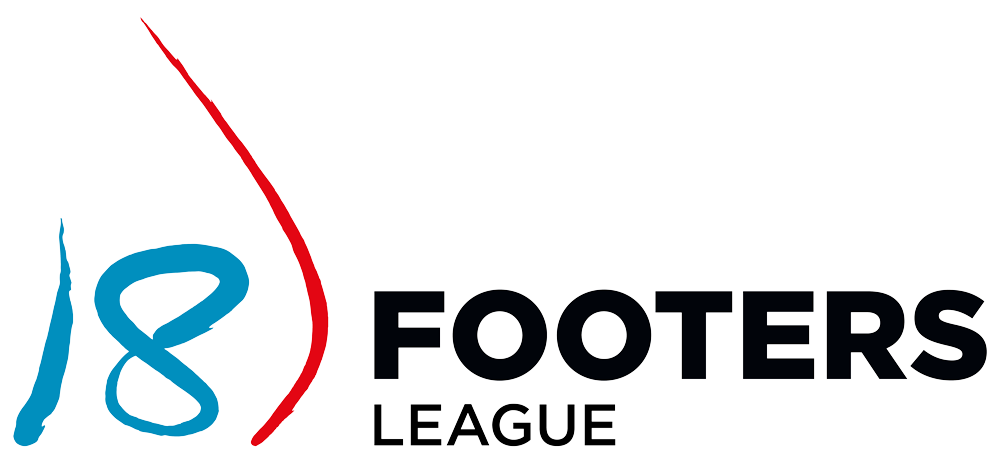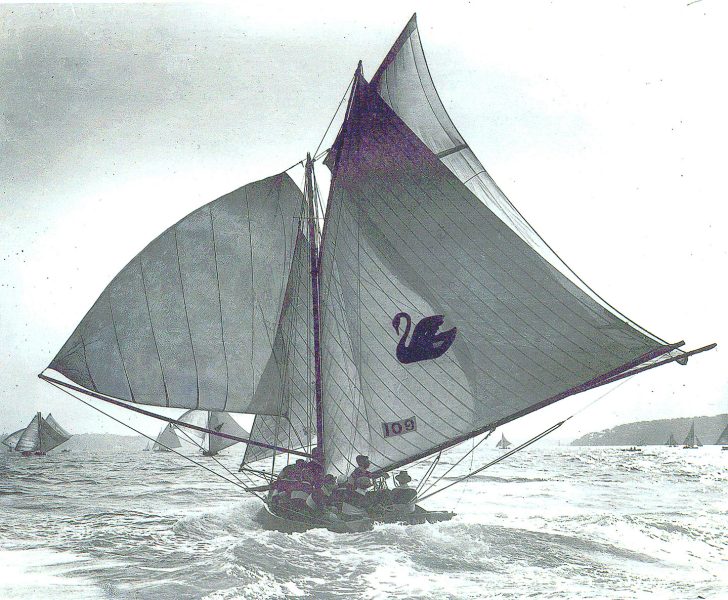A look back in time at the 18 footers early years
We are all familiar with the modern 18 footers as they speed across Sydney Harbour with their carbon fibre hulls and lightweight state-of-the-art sails and spars but they a vastly different to the original 18 footers which raced from the 1890s to the mid-1930s at a time often referred to as the ‘Big Boat Era’.
According to dimensions by the late Alf Beashel, former Secretary of the NSW 18 footers League, in Robin Elliott’s historical ‘Galloping Ghosts’, the mainsail was 600sq ft, Ballooner Jibs 470sq ft, Spinnaker 865sq ft, with the Topsail, Ringtail and Watersail making up the difference for a total of 2,577sq ft.
(Bruce Stannard’s ‘Bluewater Bushman’ claimed that Britannia regularly carried 2,800sq ft.)
At a time when the rules were at a minimum, hulls had beams between 7ft and 8ft 9in and had a depth of 2ft. They were carvel-built with half-inch cedar and usually had a half-inch thick steel centreplate.
Beashel’s dimensions also showed that all spars were solid timber. The bowsprit was 20ft long, and the main boom 29ft. The mast was 29ft high, gaff 18ft and sectioned spinnaker pole totalled 40ft.
The 18 footer class was the brainchild of Sydney businessman Mark Foy who was disappointed that nobody watched boat racing on Sydney Harbour and was determined to create a boat and a race which would solve the problem.
His idea included a fast boat with easy to recognise coloured emblems on each side of their mainsails, specially designed courses which enabled spectators to watch the entire race and a handicapping system which gave each boat an opportunity to win the race.
Once his idea became a reality with a highly successful event on Sydney Harbour in January 1892, the new style boats were taken up by Western Australia and Queensland and 18 footers raced, mainly in mixed fleets with 22s and 24 footers, throughout the 1890s.
Best known new 18 footer at the time was Australian, which was built in 1896 and was sailed by the legendary Chris Webb from 1897-1903.
Webb was the most famous 18 footer skipper during the early period of the class and a major draw card every time he raced for the Sydney Flying Squadron. By 1903 he had won 100 races and been placed 118 times in 23 yachts of various classes, but was the best-known, most successful, and most popular skipper in the 18 footers.
Possibly, the original club conducting 18 footer races in Queensland was the City of Brisbane Sailing Club, in 1895. It later became the Brisbane Flying Squadron, then Queensland Flying Squadron and finally, in 1920, the Brisbane 18 Footers Sailing Club.
Queensland designers and builders were innovative and had a reputation for being “out-of-touch” with the direction and design of 18 footer administrations by the other areas and clubs.
By the early 1900s, a handful of WA boats began racing as a fleet with crews ranging from 10-15 men. Racing was sponsored by the Mounts Bay Sailing Club, Perth Flying Squadron, and the Perth Eighteen Footer Sailing Club, and races were sailed on the old Bricklanding course.
There had been some inter-colonial events before Federation in 1901, but interstate competition lapsed until Western Australia contacted the SFS in 1906 about the possibility of an Interstate Challenge. The result was the Perth Flying Squadron Interstate Challenge Cup series, which was intended to continue over five years with the races to be held in different States.
The first championship was sailed on the Swan River in January 1907 and was won by Ted Tomlinson in Aeolus, who defeated Chris Webb in Australian II. When Webb won the next three contests (1908, 1909 and 1910) in Australian II, the fifth race became unnecessary and the boat’s owner, ‘Watty’ Ford, was awarded the cup.
Mark Foy later introduced a new interstate trophy, the Mark Foy Interstate Challenge Cup, at the start of the 1911-12 season. The inaugural event was held in Perth in 1912 and, after a thrilling race, Chris Garland’s Westana (WA) defeated NSW’s Nimrod, by 5s in front of a crowd estimated at 10,000 spectators, and that victory is now recorded as the first winner on the list of Australian Championship winners.
(All Australian Championships during the ‘Big Boat Era were staged as one race)
The 18 footers began to receive extensive media coverage, and had enthusiastic supporters on ferries of all sizes, which took patrons out to watch the races and bookmakers were on hand to take their bets.
Billy Dunn’s brand new Kismet won the next championship the following year in Sydney, then Chris Webb’s Australian III was victorious at Perth in 1913-14, which was the last contest held prior to the outbreak of WW1.
Interstate racing resumed in 1917-18 when Queensland staged a ‘Patriotic’ interstate carnival which was won by Colin Clark’s Britannia, then Frank Moppet’s Mavis won the next interstate contest, held in Sydney during the 1918-19 season.
In 1917, Australian III was disqualified for an unspecified breach of rules and Chris Webb banned for three races. Australian III’s owner ‘Watty’ Ford strongly protested and threatened to withdraw the boat. When the ban was upheld, Ford backed up his threat and both he and Chris Webb withdrew from all 18 footer racing.
(It’s believed the ban involved Webb’s refusal to vacate his customary starting position, off scratch, and take a handicap. Something he was guilty of doing several times during his career.)
There was no championship held in 1919-20 due to the Spanish Flu pandemic so the next interstate championship was staged in Sydney in 1920-21. Queensland and Western Australia each sent two boats to challenge the strong local teams. Colin Clark’s Vision, led from start to finish to comfortably defeat Mascotte and Kismet, both from NSW.
Western Australia’s Mele Bilo began racing in November 1921 and represented WA at the 1921-22 Australian Championship, which was sailed on the Swan River. Three boats from WA and two from NSW lined up for the start of the championship, which was watched by thousands of people over the course. Mele Bilo, skippered by Chris Garland, defeated two NSW boats, Kismet and H.C. Press, but unfortunately, was later destroyed in a fire.
Colin Clark won his second championship with Vision in 1922-23, but when Chris Webb was coaxed out of his self-imposed retirement to sail H.C. Press II in the 1923-24 season, it led to three more championship wins for the incredible Webb in the 1923-24, 1924-25 and 1926-27 seasons.
A minimum beam of 7ft had been introduced to the 18s in 1910 to prevent the extremes of boats which had been built with beams of 6ft (Young Jack) and 5ft 6in (Oweenee), but after the 1924-25 championship in Perth, the Queenslanders voted to remove all beam and depth restrictions and made the decision to stage the 1925-26 championship with no beam restriction.
NSW and Western Australia didn’t want to legitimise the decision and didn’t send boats to represent either State, leaving Jim Crouch’s Queensland III to win the contest from Colin Clark’s Marjorie.
Unfortunately, racing 18 footers in Western Australia disappeared in 1928 following claims that they had become too expensive to build and maintain, then a period of disagreement followed between NSW and Queensland before the next championship was held in Brisbane in 1929-30, resulting in a victory for Harold Crouch’s Waratah in a hard South-Easter.
Charlie Hayes’ snub-nosed Arawatta was the only Queensland boat to compete against the entire Sydney fleet of 26 boats when she won the 1930-31 championship then Tangalooma took out the 1931-32 event for Lance Watts on the Brisbane River.
Arawatta won again in 1932-33, on Sydney Harbour, from Australia and the new style 18, named Aberdare. The light southerly breeze didn’t suit Aberdare, with her smaller sail area, but she did enough to impress many Sydney sailors who saw that she was the alternative to the ‘Big Boats’.
The result of the acceptance of the new style (Aberdare) 18 footer led to the establishment of the NSW (now called Australian) 18 Footer League and James J Giltinan became its first President.
It signified the beginning of the end for the ‘Big Boat Era’.
Frank Quealey
Australian 18 Footers League Ltd.

